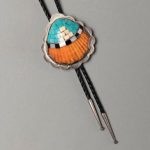Duane Maktima. Bolo tie + buckle, 1974, detail. Silver, turquoise, gold-lip mother-of-pearl, ironwood, coral, leather. SAR.1989-7-177AB. Photo by Addison Doty.
Guest post by Emily Santhanam, SAR Anne Ray Intern 2020–2021
Unbelievably, it’s been three months since I completed my Anne Ray internship with the Indian Arts Research Center (IARC) at SAR. Over the course of the program, I dove deep into the collections, approaching the objects through registration, collections management, education, and curation work. Each project taught me to navigate Native American arts stewardship in a new way. Yet what I most enjoyed—what captured my eye, mind, and interest—was creating the online exhibition The Western Aesthetic: Bolo Ties in the IARC Collection.
This exhibit brings to light Native American–made bolo ties from the 1950s onward in the IARC jewelry vaults, an under-researched area of a remarkable collection. I stumbled upon this topic while updating jewelry records in TMS (The Museum System, a collection management software); what began as a simple task of researching dates and standardizing materials soon turned into a fascination. The digital exhibit I developed went on to inform my final presentation, Bolo Ties in the Digital Age: A Case Study of Online Exhibitions Programming at the Indian Arts Research Center.
The IARC houses over fifty bolo ties, and I had the difficult job of limiting my object list to twenty-five. I knew I wanted to include artists from as many tribal affiliations as were represented in the collection—Diné, Hopi, and Laguna, Santa Clara, Santo Domingo, and Zuni Pueblos—to highlight female and male artistry, and to show a diverse set of techniques, materials, and motifs. Now, I’m excited to share three works on virtual display that I find particularly inspiring.
The first is a bolo tie and buckle set by Duane Maktima (b. 1954), a Hopi and Laguna master jeweler, designer, and craftsman. He was a 1987–1988 Katrin H. Lamon fellow at SAR and was recently awarded funding through SAR Learns! for his research on Southwest mosaic-shell and beadwork jewelry.
Maktima created this set early in his career in 1974, when he was studying as an artist-in-residence at the Museum of Northern Arizona. At the time, he was drawing inspiration from the collection around him, which consisted primarily of pottery, paintings, and katsinam.
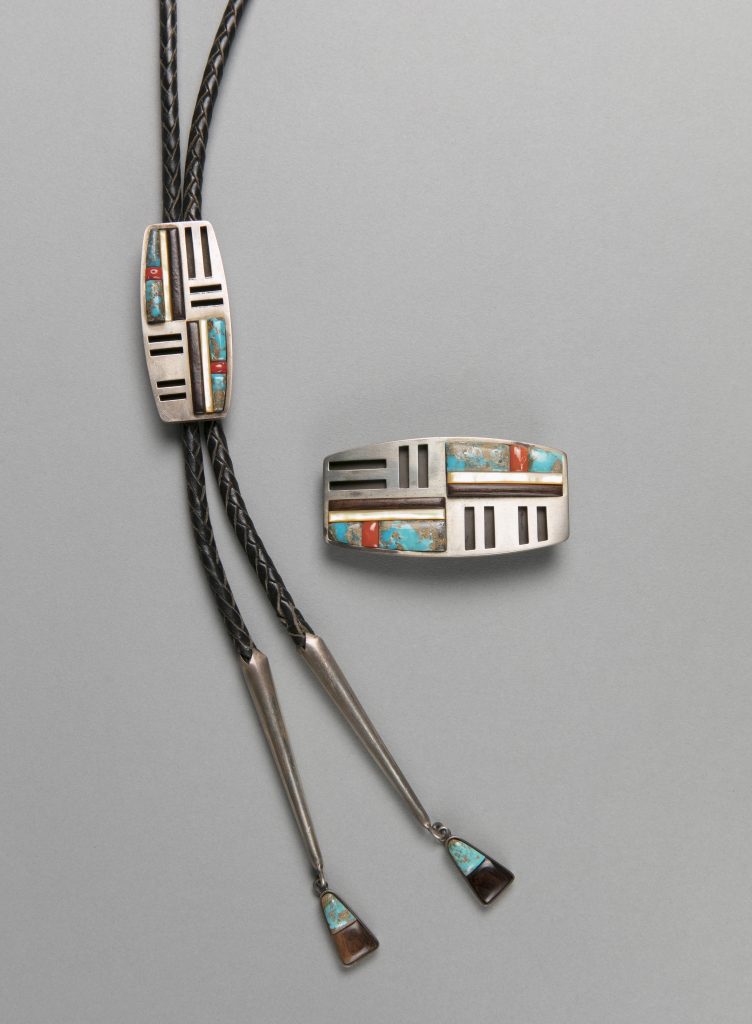
Duane Maktima. Bolo tie + buckle, 1974. Silver, turquoise, gold-lip mother-of-pearl, ironwood, coral, leather. SAR.1989-7-177AB. Photo by Addison Doty.
Looking back at how he discovered the design for his bolo, Maktima says,
I remember seeing a painting of this one priest katsina, a medicine katsina, who has this certain motif that he represents. He was carrying this staff, and the design on the staff inspired the designs on my piece. That’s what the marks looked like: it had something to do with his medicine. And the shape [of the bolo tie] is elongated, because I like the sense of incorporating something old with a modern design and shape.
The modern design and shape are precisely what attract me to this piece. It has a clean geometric aesthetic, incorporating both overlay and channel inlay techniques. The pairing of stones in the inlay work is eye-catching yet subtle, balancing turquoise, gold-lip mother-of-pearl, ironwood, and coral. When talking about his process, Maktima emphasizes the care with which he chooses his stones:
Stones are prolific in my work because of . . . what stones represent to our people, our culture. It’s something I don’t take for granted. Stones have a lot of integrity in themselves.
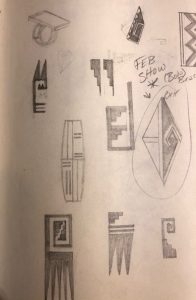
Drawing of bolo tie design
(center left) from Maktima’s
1974 sketchbook.
When it comes to stone selection and placement, Nancy (b. 1952) and Ruddell (b. 1959) Laconsello are similarly skilled. The couple—the former Zuni and Navajo, the latter Zuni—are talented artists who have worked on jewelry together since they married in 1976. Ruddell typically does the silverwork, polishing, and etching, while Nancy specializes in inlay. This piece is no exception: they created the bolo for the 1997 Pueblo Mosaic Inlay Jewelry Convocation at the IARC. SAR then purchased the piece for the permanent collection, given the intricate design work of the Navajo Yei figures on either side of the turquoise stone.
What I enjoy about this work is the combination of culturally relevant inlay, modern tie tips, and a traditional shape. The keystone slider shape dates to the 1940s and is one of the first bolo tie styles that became popularized in the West. By referencing this history and personalizing the design with tribal figures, the Laconsellos bring tradition into the present day.
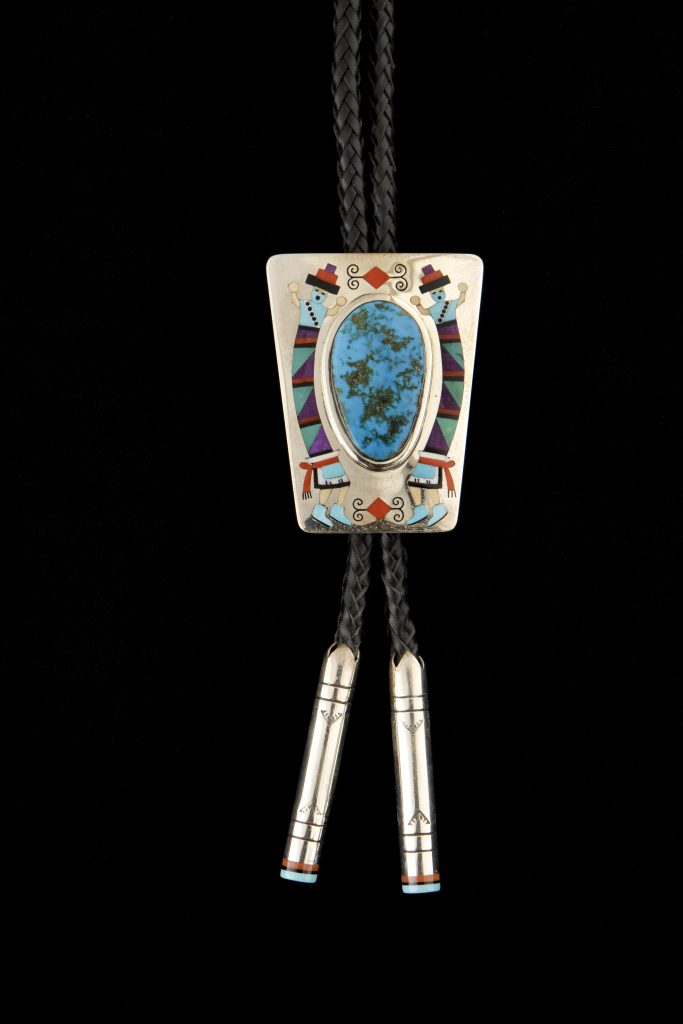
Nancy and Ruddell Laconsello. Bolo tie, 1997. Silver, turquoise, coral, mother-of-pearl, jet, melon shell, leather. SAR.1997-1-6. Photo by Addison Doty.
The final bolo tie I’ll highlight is a sculptural piece by master Zuni artist Leekya Deyuse (1889–1966). Known for his fetishes, Deyuse carved animals, birds, human figures, leaves, and other shapes, often stringing them into necklaces or setting them into silverwork. Deyuse also created early scarf slides throughout the 1930s and 1940s that are now recognized as antecedents to the bolo tie form.
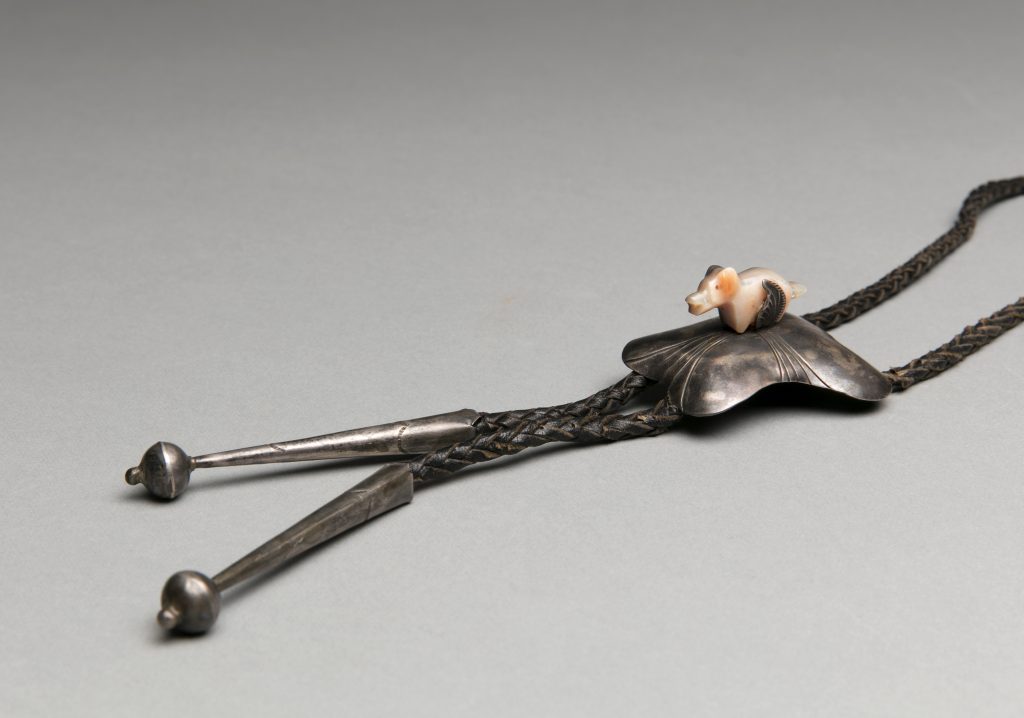
Leekya Deyuse. Bolo tie, c. 1960. Silver, abalone, leather. SAR.1989-7-187. Photo by Addison Doty.
His work housed at the IARC is a stunning example of silverwork combined with an abalone carving, possibly depicting a coyote or wolf. The silver bolo slide, also handworked, is shaped like a butterfly and has smooth incised lines. With the creation date estimated to be around 1960, this piece shows the incredible ingenuity occurring early on in the bolo tie trend and late in the career of Deyuse. The shape, style, and design of this bolo are utterly unique within our collection—not to mention that it incorporates a piece of shoestring tied behind the slider. Of the Deyuse bolo ties that are known today, few include the luminescent abalone shell featured on this piece.
Highlighting just three works of a twenty-five-piece exhibit—and of a fifty-piece collection—is a tough task. Each bolo tie has a rich backstory and meaningful cultural context that can’t be understated. While this collection is a hidden gem now, I’m hopeful that more scholarship will be undertaken to study the skillful Native American artists behind this collection. Pueblo and Diné artists weren’t just responding to tourist trends in the early to mid-twentieth century: they were repurposing materials, restructuring designs, and reimagining a Western aesthetic that’s still wrapping around our world.
I’ll be heading to Indian Market this weekend, and of the pottery, beadwork, baskets, and fashion, I know where I’ll spend my time—with the bolo ties.

